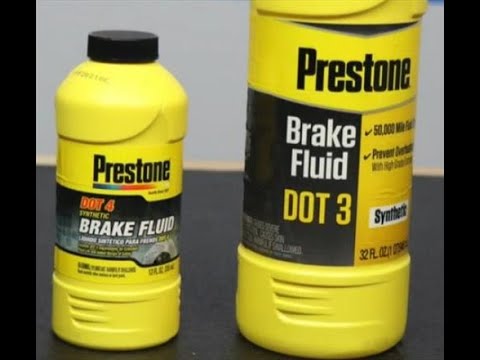Can You Mix Dot 3 And Dot 4?
Yes, you can mix Dot 3 and Dot 4 brake fluids. Mixing them won’t cause any issues or harm to your vehicle’s braking system.
Brake fluid is a vital component in ensuring the proper functioning of a vehicle’s braking system. The two most commonly used types of brake fluid are Dot 3 and Dot 4. While it is generally recommended to use the same type of brake fluid as specified in your vehicle’s owner manual, it is often asked whether it is possible to mix Dot 3 and Dot 4 fluids.
This article aims to provide a concise and accurate answer to this frequently asked question. By understanding the compatibility of these brake fluids, you can make informed decisions about your vehicle’s maintenance and potentially avoid costly repairs. So, let’s deep dive into whether mixing Dot 3 and Dot 4 brake fluids is safe or not.
Understanding Dot Brake Fluid Ratings
DOT brake fluid ratings are essential to ensure the safe and efficient operation of your vehicle’s braking system. These ratings, established by the Department of Transportation (DOT), indicate the fluid’s performance characteristics and compatibility with your vehicle’s braking system.
What are DOT brake fluid ratings?
DOT brake fluid ratings refer to a series of standards that indicate the fluid’s boiling point, viscosity, and chemical composition. The most common ratings are DOT 3, DOT 4, DOT 5, and DOT 5.1.
Different types of DOT brake fluids:
1. DOT 3: This is a glycol-based brake fluid suitable for most vehicles. It has a lower boiling point compared to DOT 4 and 5 fluids.
2. DOT 4: This is also a glycol-based fluid, but with a higher boiling point and improved performance compared to DOT 3.
3. DOT 5: Unlike DOT 3 and 4, DOT 5 is silicon-based and is not compatible with most vehicles.
4. DOT 5.1: This fluid is similar to DOT 4 but has a higher wet boiling point, making it suitable for high-performance vehicles.
Importance of using the correct rating:
Using the correct DOT brake fluid rating is crucial because it ensures proper braking performance and maintains the safety of your vehicle. Using an incompatible fluid can lead to brake failure and compromise your ability to stop effectively.
Compatibility Of Dot 3 And Dot 4
DOT 3 and DOT 4 brake fluids are commonly used in vehicles. They are similar in many ways, but can you mix them? DOT 3 and DOT 4 brake fluids are not fully compatible and mixing them is not recommended.
Both DOT 3 and DOT 4 brake fluids are made from glycol ether base and have similar chemical properties. However, there are differences in their boiling points and additive compositions, which can affect their performance when mixed together.
Mixing DOT 3 and DOT 4 brake fluids can result in reduced brake performance and compromised safety. When brake fluids are mixed, there can be a decrease in the boiling point and viscosity, leading to reduced braking efficiency.
It is recommended to flush the brake system and use a single type of brake fluid to avoid potential problems. If you are unsure about the type of brake fluid to use, check your vehicle’s owner manual or consult a professional mechanic.
| Compatibility | DOT 3 | DOT 4 |
|---|---|---|
| DOT 3 | ✔ | ✖ |
| DOT 4 | ✖ | ✔ |
It is important to understand the compatibility of brake fluids to ensure proper maintenance of your vehicle’s braking system.
Advantages And Disadvantages Of Mixing Dot 3 And Dot 4
Advantages of mixing DOT 3 and DOT 4 brake fluids:
- Increased versatility: Mixing DOT 3 and DOT 4 brake fluids allows for flexibility in topping up the brake fluid reservoir, preventing the need to purchase a specific type of brake fluid.
- Compatibility with older brake systems: Mixing DOT 3 and DOT 4 brake fluids can be beneficial for older brake systems that may not have been designed to handle the higher boiling point of DOT 4 fluid.
Disadvantages of mixing DOT 3 and DOT 4 brake fluids:
- Potential loss of performance: Mixing different types of brake fluids can result in a lower overall boiling point, potentially compromising the braking performance of your vehicle.
- Difficulty in determining the fluid’s boiling point: Mixing different brake fluids can make it challenging to accurately determine the boiling point of the fluid in your brake system.
Considerations before deciding to mix:
- Manufacturer recommendations: It is crucial to refer to the manufacturer’s recommendations for your vehicle’s brake fluid to ensure proper compatibility and performance.
- System condition: Assess the condition of your brake system, including the seals and hoses, before deciding to mix brake fluids. In some cases, it may be more beneficial to use a single type of brake fluid.

Credit: blog.amsoil.com
Frequently Asked Questions For Can You Mix Dot 3 And Dot 4?
What Happens If I Mix Dot 3 With Dot 4 Brake Fluid?
Mixing DOT 3 with DOT 4 brake fluid can cause a decrease in brake performance and reduce overall effectiveness. It is important to use the correct type of brake fluid specified by your vehicle manufacturer to ensure safety and optimal brake function.
Is Dot 3 Compatible With Dot 4?
Yes, DOT 3 and DOT 4 brake fluids are compatible with each other.
Can You Mix Dot 3 With Synthetic Brake Fluid?
No, it is not recommended to mix DOT 3 brake fluid with synthetic brake fluid.
Is It Ok To Mix Dot 4 And Dot 5 Brake Fluid?
Mixing DOT 4 and DOT 5 brake fluid is NOT recommended. It can cause performance issues, damage seals, and affect braking ability. Stick to using one type of brake fluid to ensure proper function and safety.
Conclusion
To summarize, it is not recommended to mix DOT 3 and DOT 4 brake fluids as they have different chemical compositions. Doing so may compromise the overall performance of your braking system and even lead to potential safety hazards. It’s crucial to always follow manufacturers’ guidelines and use the appropriate brake fluid specified for your vehicle.
By ensuring the correct fluid is used, you can maintain optimal braking efficiency and guarantee a safer driving experience.
